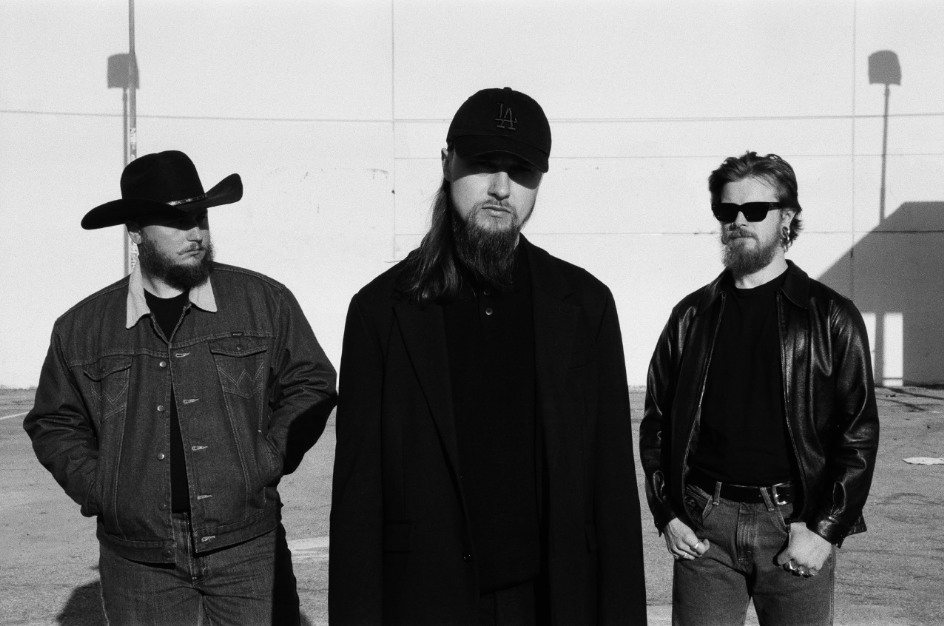 Molchat Doma. Image via publicist.
Molchat Doma. Image via publicist.
Molchat Doma are guys who like to have fun. Seriously. They play video games, watch hockey, and go to concerts: since moving from Minsk to Los Angeles in 2020, Egor Shkutko and Roman Komogortsev (two-thirds of the band along with Pavel Kozlov) have been attending as many as they can — Egor’s recent favorite was Deftones with System of a Down, while Roman was especially impressed with Queens of the Stone Age. Listening to the stern, frost-bitten sound of the gothy post-punk band’s previous albums might conjure the image of its creators as equally grim people, incapable of feeling pleasure. But Molchat Doma are now ready to reflect brighter dimensions in their music with their fourth album Belaya Polosa (White Stripe in English), a project that, against all odds, can be described as infectious.
Over a video call through a translator, Shkutko speaks from a dark room lit only by his computer glow, while Komogortsev phones in from a studio decked out with vintage synthesizers, guitars, and a flag that reads “NOBODY CARES. WORK HARDER,” the same one that’s on the wall of my gym. They’re about as far from the modern notion of TikTok music sensations as you can get, but the app has introduced an unwitting generation of short-form video fiends to their music.
It began with “Sudno (Boris Ryzhy),” from their 2018 album Etazhi. Not long after the album’s re-release on Sacred Bones, “Sudno,” a song about a bed-ridden acceptance of death, became the soundtrack for hundreds of thousands of TikToks. Unsurprisingly, as appreciative as both Shkuto and Komogortsev are for all their new fans and the opportunities they’ve brought with them, they have little to no interest in following the whims of internet trends: “Music first,” Komogortsev says in a rare lapse into English from his native tongue.
“Molchat Doma itself is an experiment. Now, we feel more secure in ourselves — as a band, and [in] what we want to achieve sonically.
Every Molchat Doma album reflects a different musical era. Their 2017 debut S Krish Nashih Domov and Etazhi channeled the sounds of the early ’80s: Joy Division, early Cure, and Kino, giants of Soviet-era rock. Things started to shift on 2020’s Monument: the cobwebs in their shadowy disco began to fall away, and colors in their EBM-inspired sound began to emerge. Slowly, they say, they were becoming the band they’d always wanted to be.
Thanks to three albums worth of experience and global attention that showed no signs of abating, Molchat Doma were finally ready to create Belaya Polosa. Chiefly inspired by the ’90s and Depeche Mode, the album is the first that the band has recorded in their new L.A. studio — previous albums were pieced together on an old laptop in a bedroom, Shkutko says in a tone that suggests exasperation as much as pride. It’s this era of music, Komogortsev says, that the band mainly grew up on, its visual iconography seared into their retinas like the MTV logo burned into the bottom right of a CRT TV. Finally, that glossy energy would fully make its way into Molchat Doma’s music.
Belaya Polosa begins with a swell of Prophet-sized synths on “Ty Zhe Ne Znaesh Kto Ya” (translated: “You Don’t Know Who I Am”), its filters opening into a yawn that suggests some kind of barrier melting away. A new and shinier fidelity boosts the dancefloor ambitions of tracks like “Kolesom" and "Belaya Polosa," songs indebted to Violator-era Depeche Mode down to the ruinous electric guitar twang and Shkutko’s vocals, studiously modeled on Dave Gahan.
As much as Shkutko and Komogortsev cop to their influences, they stress that they wanted to stretch these sounds to their limits. Sampling became a tool for the first time, with sounds from the legendary Zero-G sample libraries appearing in the music. You can hear them prevalently in "Chernye Tsvety," where the band’s flickering drum machines are replaced with a broken break that takes the song into the realm of trip-hop.
One can imagine the pressure Molchat Doma must have faced to make an album worth of “Sudno” remakes. The song’s grim and charging sonics are a defining chapter in pandemic-era music and aesthetic catnip for disaffected, dooming youngsters all over the world. Some see their futures reflected in the music; others just want to get a fit off to a cool song. The band’s subsequent success and sold-out tours suggest they’ve escaped memeification and built a dedicated base of true fans rather than a fleet of doomer wojaks. And even though Belaya Polosa is not an express rejection of their early sound’s explosion online, the stark contrast is admirable in a bottom-line-driven industry. “As individuals,” Shkutko says, “we change and develop as people, and so does our music.”
“Molchat Doma itself is an experiment,” Kamahortsau says. “Now, we feel more secure in ourselves — as a band, and [in] what we want to achieve sonically.” That new confidence has helped them process surprised audience responses when they play new songs live. “It's like a little game,” Kamahortsau says, “to tease fans with these new songs and see what the reaction is.” Previous eras of music may give us hints of where Molchat Doma are going next. But, to the band’s credit, they’ll never be a complete map.